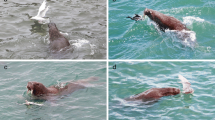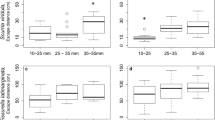Abstract
During intraspecific agonistic encounters in snapping shrimp (Alpheus heterochaelis) the behaviour of the snapper, emitting a fast water jet by very rapid closure of the large modified snapper claw, and the receiver was analysed by single frame video analysis before, during, and after the snap. During snapping the opponents usually face each other. Snapping is most frequently preceded by touch of frontal appendages. The snapping animal keeps its snapper claw slightly across the midline, shielding frontal body parts, and its tailfan bent downwards. The mean claw cocking duration (generating muscle tension) before snapping amounts to about 500 ms. In 58% of the snaps, the snapper claw pointed at the opponent, its claws, densely covered with sensory hairs, representing the main target of the water jet. The mean distance for these directed snaps was 0.9 cm, while undirected snaps were emitted from larger distances of on average 3.4 cm. The snapper usually withdraws immediately after snapping, the receiver approaches. Initial snaps are often answered by return snaps and both are emitted from smaller distances and hit more often than subsequent snaps.
Similar content being viewed by others
References
Barki A, Karplus I and Goren M 1991 The agonistic behaviour of the three male morphotypes of the freshwater prawnMacrobrachium rosenbergii (Crustacea, Palaemonidae);Behaviour 116 252–277
Batschelet E 1981Circular statistics in biology (London: Academic Press)
Breithaupt T, Schmitz B and Tautz J 1995 Hydrodynamic orientation of crayfish (Procambarus clarkii) to swimming fish prey;J. Comp. Physiol. A177 481–491
Brooks W K and Herrick F H 1891 The embryology and metamorphosis of the Macroura;Mem. Natl. Akad. Sci. Washington 5 319–576
Caldwell R L 1987 Assessment strategies in stomatopods;Bull. Mar. Sci. 41 135–150
Caldwell R L and Dingle H 1975 Ecology and evolution of agonistic behavior in Stomatopods;Naturwissenschaften 62 214–222
Conover M R and Miller D E 1978 The importance of the large chela in the territorial and pairing behaviour of the snapping shrimp,Alpheus heterochaelis;Mar. Behav. Physiol. 5 185–192
Copp N H 1986 Dominance hierarchies in the crayfishProcambarus clarkii (Girard, 1852) and the question of learned individual recognition (Decapoda, Astacidea);Crustaceana 51 9–24
Dingle H 1983 Strategies of agonistic behavior in Crustacea; inStudies in adaptation: The behavior of higher Crustacea (eds) S Rebach and D W Dunham (New York: Wiley) pp 85–111
Downer J 1989 Mit den Augen der Tiere. Teil: Laute der Natur. Universum, BBC and WDR (Westdeutscher Rundfunk)
Elwood R W and Neil S J 1992Assessment and decisions. A study of information gathering by hermit crabs (London: Chapman and Hall)
Gruner H-E 1993Lehrbuch der speziellen Zoologie. Band I: Wirbellose, 4. Teil: Arthropoda (Jena: Gustav Fischer Verlag)
Hazlett B A 1962 Aspects of the biology of snapping shrimp (Alpheus andSynalpheus);Crustaceana 4 82–83
Hazlett B A and Winn H E 1962 Sound production and associated behavior of Bermuda Crustaceans (Panulirus, Gonodactylus, Alpheus, andSynalpheus);Crustaceana 4 25–38
Huber R and Kravitz E A 1995 A quantitative analysis of agonistic behavior in juvenile American lobsters (Homarus americanus L.);Brain Behav. Evol. 46 72–83
Hughes M 1996a Size assessment via a visual signal in snapping shrimp;Behav. Ecol. Sociobiol. 38 51–57
Hughes M 1996b The function of concurrent signals: visual and chemical communication in snapping shrimp;Anim. Behav. 52 247–257
Hyatt G W 1983 Qualitative and quantitative dimensions of crustacean aggression; inStudies in adaptation: The behavior of higher Crustacea (eds) S Rebach and D W Dunham (New York: Wiley) pp 113–139
Knowlton N and Keller B D 1982 Symmetric fights as a measure of escalation potential in a symbiotic, territorial snapping shrimp;Behav. Ecol. Sociobiol. 10 289–292
Knowlton R E and Moulton J M 1963 Sound production in the snapping shrimpsAlpheus (Crangon) andSynalpheus;Bioi. Bull. 125 311–331
MacGinitie G E 1937 Notes on the natuml history of several marine Crustacea;Am. Midi. Nat. 18 1031–1036
MacGinitie G E and MacGinitie N 1949Natural history of marine animals (New York: McGmw Hill)
Nolan A N and Salmon M 1970 The behaviour and ecology of snapping shrimp (Crustacea:Alpheus heterochelis andAlpheus normanni);Forma et Functio 2 289–335
Pavey C R and Fielder D R 1996 The influence of size differential on agonistic behaviour in the freshwater crayfish,Cherax cuspidatus (Decapoda; Pamstacidae);J. Zool. London 238 445–457
Read A T and Govind C K 1991 Composition of external setae during regeneration and transformation of the bilaterally asymmetric claws of the snapping shrimp,Alpheus heterochelis;J. Morphol. 207 103–111
Ritzmann R E 1974 Mechanisms for the snapping behavior of two Alpheid shrimp,Alpheus californiensis andAlpheus heterochelis;J. Compo Physiol. 95 217–236
Schein H 1975 Aspects of the aggressive and sexual behaviour ofAlpheus heterochaelis Say;Mar. Behav. Physiol. 3 83–96
Schein H 1977 The role of snapping inAlpheus Jzeterochaelis Say, 1818, the big-clawed snapping shrimp;Crustaceana 33 182–188
Schmitz B, van der Wall M and Simon B 1995 Underwater acoustics of snapping in the pistol shrimp (Alpheus heterochaelis);Verh. Dtsch. mol. Ges. 88 215
Schultz S, Wuppermann K and Schmitz B 1998 Behavioural intemctions of snapping shrimp (Alpheus heterochaelis) with conspecifics and sympatric cmbs (Eurypanopeus depressus);Zool.-Anal. Complex Syst. (Suppl. I) 101 85
SöderbÄck B- 1991 Interspecific dominance relationship and aggressive intemctions in the freshwater crayfishesAstacus astacus (L.) andPacifastacus leniusculus (Dana);Can. J. zool. 69 1321–1325
Sullivan J and Schmitz B 1997 The mechanosensory system of snapper and pincer claw in snapping shrimp (Alpheus heterochaelis); inProceedings of the 25th Göttingen Neurobiology Conference 1997 (eds) N Flsner and H WÄssle (Stuttgart: Thieme) Vol. 2, p 250
Suzuki D 1986 Stunning sounds. Series: The nature of things; CBC (Canadian Broadcasting Corporation)
Volz P 1938 Studien über das“Knallen” der Alpheiden. Nach Untersuchungen anAlpheus dentipes Guérin undSynalpheus laevimanus (Heller);Z. Morphol. ökol. Tiere 34 272–316
Williams A B 1984Shrimps, lobsters, and crabs of the Atlantic coast of the Eastern United States, Maine to Florida (Washington DC: Smithsonian Institution Press)
Author information
Authors and Affiliations
Corresponding author
Rights and permissions
About this article
Cite this article
Schmitz, B., Herberholz, J. Snapping behaviour in intraspecific agonistic encounters in the snapping shrimp (Alpheus heterochaelis). J. Biosci. 23, 623–632 (1998). https://doi.org/10.1007/BF02709175
Received:
Accepted:
Published:
Issue Date:
DOI: https://doi.org/10.1007/BF02709175




